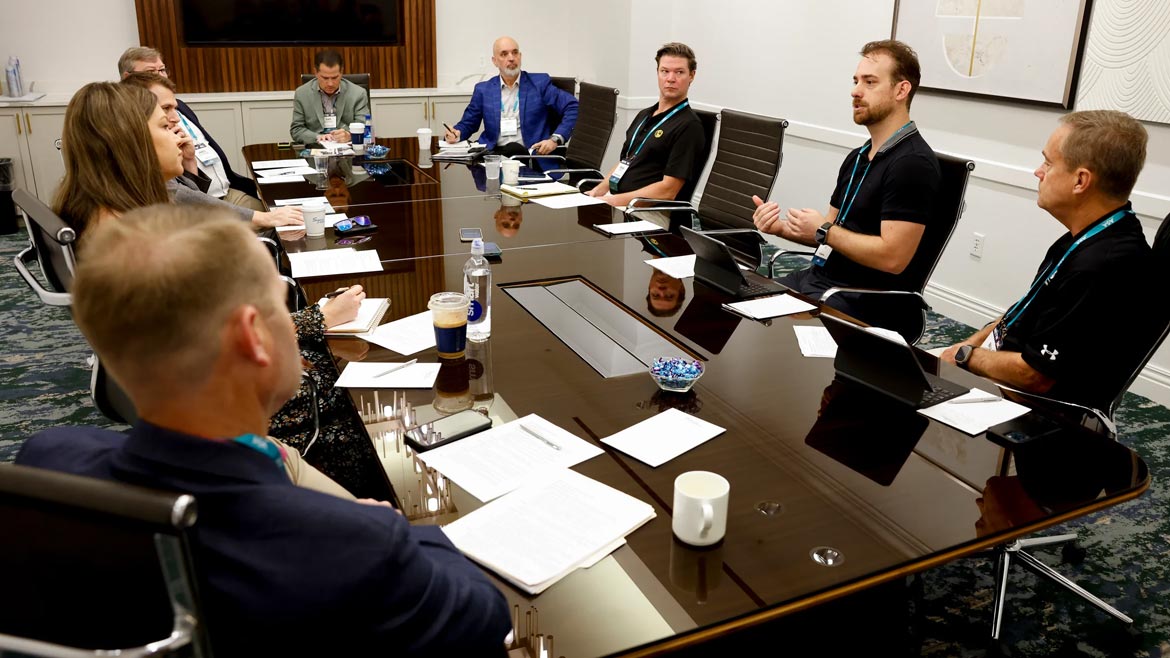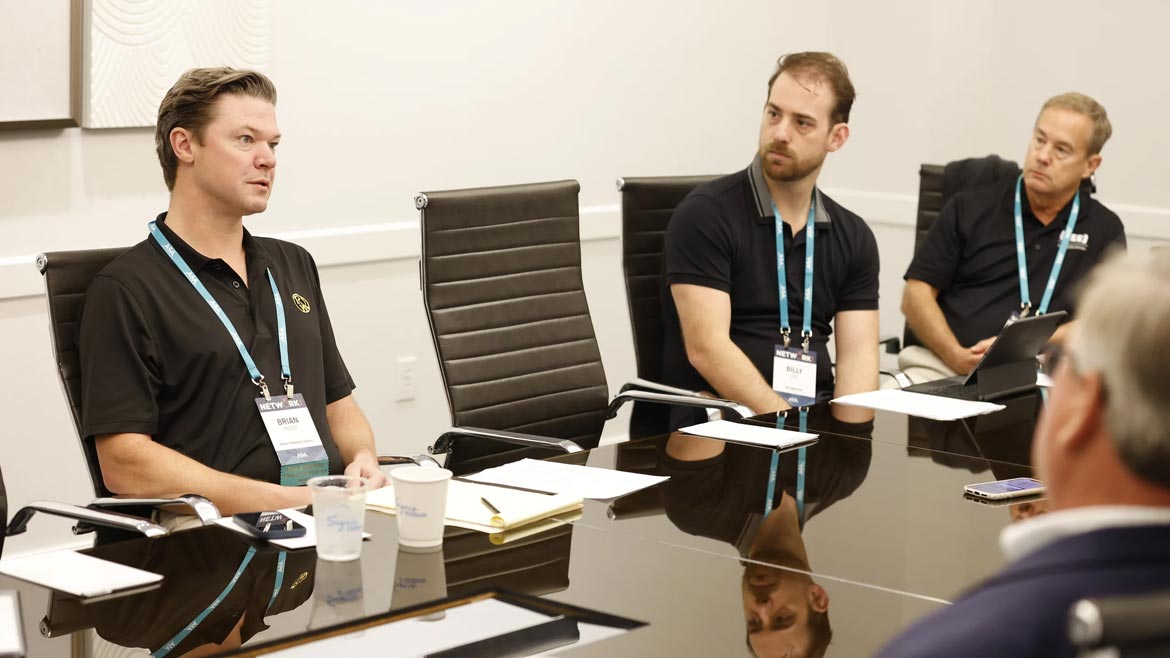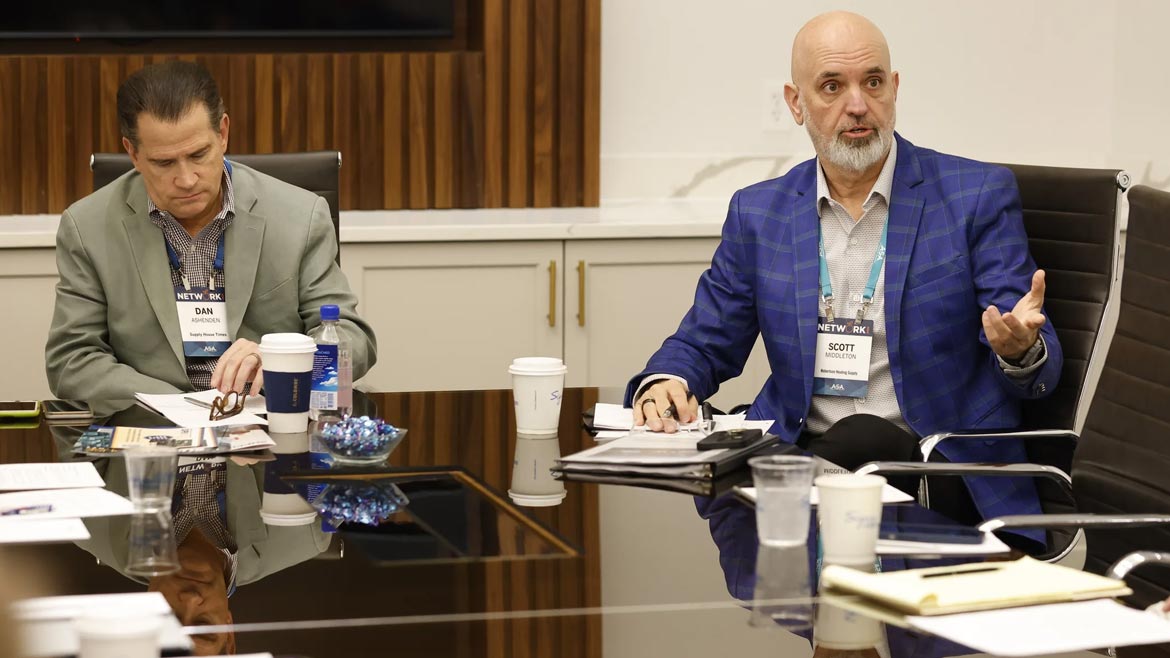More than 850 attendees — including 86 distributor-members that represent more than $50 billion in annual sales — gathered in Orlando, Florida November 8-10 for the American Supply Association’s (ASA) annual NETWORK event. In addition to the scheduled Great Idea Roundtable sessions, panel discussions and numerous educational sessions, Supply House Times had the exclusive opportunity to sit down with seven distributor members to tackle hot-button topics facing the supply chain.
For the past 14 years, ASA has recommended a handful of distributors from across the country to participate in a roundtable discussion with Supply House Times to get a direct pulse for the state of distribution. The 2023 roundtable participants were:
- Benn Harms, director of operations, Plumbing & Heating Wholesale;
- Scott Middleton, executive vice president, Robertson Heating Supply;
- Bill Lee, vice president, sales, Lee Supply Corp.;
- Billy Lee, wholesale channel manager, Lee Supply Corp.;
- Caleb Owen, executive vice president, Eastern Industrial Supplies;
- Brian Priest, vice president, operations, Reeves Wiedeman; and
- Jim Richardson, president, Raritan Group.
Opportunistic is how Eastern Industrial Supplies’ Owen describes market conditions in the Southeast throughout 2023. “There are so many opportunities out there; you have to be smart about what areas you focus on,” he says.
Coming off of a record-setting 2022 due to inflation, several distributors point out that the residential markets are flat or slightly down in 2023. “Our record performance in 2022 was largely fueled by price increases,” Middleton says. “With rising interest rates, the residential market is a mixed bag; new construction has slowed but our remodel business remains fairly strong. But it varies by region.”
Participants that are active in the multifamily and/or MRO markets say performance in those sectors has been strong throughout 2023. “We’re fortunate to be in areas with college towns that need repair and maintenance work,” Priest says. “And there are many people purchasing second, vacation homes down near the Ozarks which has been beneficial. The multifamily market just doesn’t seem to stop while residential has slowed down.”
Plumbing & Heating Wholesale’s Harms agrees, saying that multifamily has been booming throughout the Midwest. “While residential has dipped, the custom home market is still strong which has helped showroom performance stay positive,” he says.
Bill Lee points out that the funnel of new construction homes is still good, but it’s began to slow and large tract builders like Pulte and D.R. Horton are off by roughly 30%. “The apartment business is good now, but when you look our 18 months, it’s down maybe 50% which is a concern,” he adds.
Right sizing inventory
As distributors face possible deflation and continued supply chain recovery, the challenge to right size inventory is ongoing, especially headed into an unpredictable election year.
“We’re somewhat still recovering from the supply chain issue of COVID,” Harms points out. “Heading into 2024 with everything going on in Ukraine and Israel, it’s difficult to know what to expect, but we are prepared for something to happen, we just can’t know exactly what that is.”
Priest agrees, adding that the level of economic unpredictability is prominent. “We’re trying to repurpose inventory from other branches, and we’re working with our purchasing departments to buy better, despite the level of unpredictability.”
Owen adds that Eastern is keeping a close eye on the flow of money and looking inward to address DSOs.
Richardson says the supply chain has improved overall with the exception of domestic brass. “For the most part we are back to pre-COVID terms and we’re trying to get our inventory to a healthy spot; somewhere between 2020 and what it was Q1 of 2023.”
Priest bring up the challenge of data flow from suppliers. “It’s still a struggle to be on the same page with manufacturers in terms of product sales and when the product will arrive,” he says. “The lack of accurate data makes planning extremely difficult.”
Middleton says lead times in both plumbing and HVAC have not completely returned to what they were pre-COVID, and due to inflation, it takes significant capital and resources to run a successful distributorship. “Our inventory investment is larger than ever,” he says. “It’s more expensive to be in this business; products cost more. Plus, vendors still have some unpredictability in hitting their lead times. This uncertainty drives us to increase inventory to have the items we need on hand.”
In order to stay on top of unpredictable market conditions, distributors are getting creative and proactive.
“Our individual teams (accounting, sales, etc.) are breaking out every week in meetings to share information,” Owen says. “Those meetings have been huge for us.”
Owen adds that attending ASA events to share best practices and touch base with vendors is vital, especially during times like this.
Middleton agrees, saying their teams meet frequently to stay on top of and address any areas of concern. “This is our business,” he says. “We work together to figure it out. And that’s a reason we come to ASA. We’re all in this together and can learn from each other; communication and in-person relationships will help us all.”

Intellectual capital, cybersecurity and consolidation
Supply House Times always asks distributors to identify the top challenges they are facing. Many cited challenges – such as price increases, labor shortages, consolidation and data management – are somewhat evergreen. But this year, the participants focused on a couple “new” challenges: Loss of intellectual capital and cybersecurity.
“We are concerned with the amount of intellectual capital that our industry will be losing over the coming years,” Priest points out. “Not just with our employees, but our clients as well, are going to see a large number of Baby Boomers and members of the older generations retire. These are the people that have an infinite amount of industry and product knowledge that we will no longer have access to once they’re retired.”
Priest says the goal is to keep these knowledgeable people around as long as possible, soaking up all of the information they can, but he still anticipates that the impact of this mass retirement will be substantial for the industry.
In response to Priest’s point, Owen says he’s concerned about customer relationships moving forward. “I’ve noticed in our industry a lot of the newer salespeople don’t ask enough questions,” he says. “They might be getting to know their customers, but they don’t ask those questions to develop and grow the relationships. That’s something we’re focused on making a top priority to ensure we don’t leave margin on the table.”
Owen adds that lack of education is a huge threat to the industry. “How do we transfer that knowledge of the people leaving us to the next generation?” he asks.
According to Bill Lee, the changing relationships between manufacturers and distributors is a cause for concern. “Many manufacturers now call directly on our own customers,” he says. “Home Depot also has salespeople out on the road calling on our customers. And we have to pay close attention to the role of the rep as well; at one point they would only call on the wholesaler-distributors, but now they’re calling on the designers and contractors too.”
Another top concern mentioned around the table was cybersecurity. While some may think only larger companies are at risk for cyberattacks, in 2023 small businesses – those with 1,000 employees or less - accounted for 43% of all cyberattacks annually.
Harms says Plumbing & Heating Wholesale discusses cybersecurity on a weekly basis. “We’re constantly talking about it and training to it,” he says. “All it takes is one wrong click, and we want to make sure our employees are aware of that.”
Middleton agrees, adding that it’s key to understand you are likely never 100% secure. “We all think we are secure, but talk to the companies who have suffered cyberattacks; most thought they were secure at the time,” he says. “We need to be diligent, continue to train our teams and test ourselves.”
The third top challenge these distributors brought up was consolidation at all levels of the industry. “We’re seeing consolidation in every sector,” Middleton says. “Manufacturers, rep agencies, distributors and contractors are merging, and private equity is active in buying contracting firms; this is a concern for us. We spend time building relationships and working with and understanding our partners, so when they’re bought by another company it can fracture those relationships and can put us in a place where we may no longer be dealing directly with the ultimate decision makers. Being active at all levels in your market is critical.”
Bill Lee echoes the concern of consolidation, specifically when it comes to companies that are out of state or out of a distributor’s geographic jurisdiction.
Harms says he’s seeing manufacturers purchasing distributors. “This is concerning because when they buy up distributors in our area, the manufacturers essentially become a competitor in our marketplace.”
The group also pointed out that in some areas, builders are acquiring contracting companies, again infringing on the distributors' ability to maintain decades-long relationships with their usual customers.
While there isn’t much that can be done to stop consolidation, these distributors agree buying groups and ASA are doing a good job at being proactive to prepare distributor members to combat the negative effects.
“This is why our buying groups and ASA are so important,” Middleton says. “These groups give us the opportunity to work and band together, to learn and share best practices and communicate.”
Harms agrees, adding that buying groups are also providing resources and helping independent distributors with their succession planning. “You hear of distributors selling to larger international companies, or private equity, which takes them out of the group because they don’t have a proper succession plan and don’t know what else to do,” he says. “When that happens it removes that buying power from the group, affecting everyone. Buying groups can be proactive in assisting with that planning.”
Priest points out there is a level of opportunity to take advantage of as competitors become acquired. “When our competition is being bought they are focused on their margins,” he says. “We tell our people to be sure to have a sense of urgency with the customer and focus on providing that top-shelf service to separate us from the competition who may be focused on other things and operating under tighter margins.”


ECommerce and automation
Next up was the conversation around how eCommerce is developing in the PHCP-PVF world. Billy Lee says Lee Supply Corp. feels confident about its use of eCommerce. “We’re up about 12% total sales with our B2B business since implementing eCommerce,” he says.
Bill Lee adds that the company treats its eCommerce platform as a counter. “It’s an extension of our counter with longer hours and more instant information,” he says. “Our website is used by almost 70% of our customers for informational purposes, which reduces the number of calls coming in, boosting our productivity.”
Pointing out that the eCommerce needs to be user-friendly to be effective, Bill Lee says that everything the company puts out digitally must be intuitive, attractive and time-saving. “If we can save the contractor time it gives them the opportunity to do more business with us.”
Middleton says Robertson Heating Supply also feels it’s ahead of the game in eCommerce. “We’re fortunate that our HVAC equipment and other large ticket items help drive our eCommerce business,” he says. “And 80% of our eCommerce business is customers reordering material; our contractors are using it to order items in the easiest way possible. We’re promoting the platform because we believe that when we get them on our site or app, we’re going to get some wins and keep customers from going elsewhere.”
‘Jazzed’ for the future
These distributors agree that tackling all of the hurdles mentioned above is done with constant communication, relationship development and access to industry insights; all of which are benefits they find in ASA.
“The education programs for new hires and the commodity reports each month are invaluable for us,” Richardson says. “The comradery that ASA provides and knowing they have our back in Washington are benefits we find extremely helpful.”
According to Harms, ASA has helped open his eyes to new ideas and perspectives. “It’s easy to get stuck in your own bubble, focused on what’s going on in your marketplace,” he says. “Engaging with ASA helps open our eyes to different ways of operating and different ways of thinking. It’s a group of people that are invested in helping each other, and you can’t put a price on that.”
Middleton agrees, adding that the ability to have access to a pool of peers year-round is extremely helpful. “The engagement from coming to the events is great, but there are also 15 to 20 times a year that we have a question, and ASA gives us the conduit to have relationships with others around the country who we can pick up the phone and call.”
To wrap things up, Supply House Times asked the participants to use one word to describe their feelings about business heading into the new year. The consensus around the table was that excitement and optimism outweigh the concerns tackled throughout this conversation.
“I’ll say that I’m jazzed,” Harms says. “We have so much going on this year, and have invested heavily into our team and our infrastructure recently to prepare us for what we have planned. There’s a ton of opportunity in the market and we have an awesome team ready to go after it.”
Middleton uses the word “promising.” “Not everything is going to go our way,” he says. “There are always wins and losses, but at the end of the day it’s exciting to work with a team you’re proud of and be a part of an industry that is vital to the health of our nation.”





